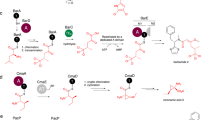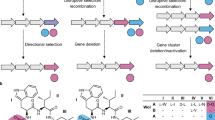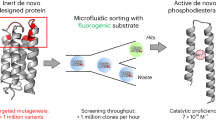Abstract
α/β hydrolase fold thioesterases (TEs) play fundamentally important roles in polyketide and non-ribosomal peptide biosynthesis. Type-I TEs, fused at the C-terminus of multi-modular enzymatic assembly lines, dictate the overall molecular shapes of assembly-line products, while standalone type-II TEs maintain assembly-line activity through proofreading functions. Beyond these established roles, recent studies have elucidated several distinct TE functions that expand the functional versatility of these enzymes. This review summarizes recently discovered non-canonical functions of TEs in bacterial non-ribosomal peptide biosynthesis.
This is a preview of subscription content, access via your institution
Access options
Subscribe to this journal
Receive 12 print issues and online access
$259.00 per year
only $21.58 per issue
Buy this article
- Purchase on SpringerLink
- Instant access to full article PDF
Prices may be subject to local taxes which are calculated during checkout








Similar content being viewed by others
References
Süssmuth RD, Mainz A. Nonribosomal peptide synthesis-principles and prospects. Angew Chem Int Ed Engl. 2017;56:3770–821.
Caswell BT, de Carvalho CC, Nguyen H, Roy M, Nguyen T, Cantu DC. Thioesterase enzyme families: functions, structures, and mechanisms. Protein Sci. 2022;31:652–76.
Ozhelvaci F, Steczkiewicz K. α/β Hydrolases: toward unraveling entangled classification. Proteins. 2025;93:855–70.
Little RF, Hertweck C. Chain release mechanisms in polyketide and non-ribosomal peptide biosynthesis. Nat Prod Rep. 2022;39:163–205.
Adrover-Castellano ML, Schmidt JJ, Sherman DH. Biosynthetic cyclization catalysts for the assembly of peptide and polyketide natural products. ChemCatChem. 2021;13:2095–116.
Kotowska M, Pawlik K. Roles of type II thioesterases and their application for secondary metabolite yield improvement. Appl Microbiol Biotechnol. 2014;98:7735–46.
Horsman ME, Hari TP, Boddy CN. Polyketide synthase and non-ribosomal peptide synthetase thioesterase selectivity: logic gate or a victim of fate? Nat Prod Rep. 2016;33:183–202.
Matsuda K, Wakimoto T. Penicillin-binding protein-type thioesterases: an emerging family of non-ribosomal peptide cyclases with biocatalytic potentials. Curr Opin Chem Biol. 2024;80:102465.
Rauwerdink A, Kazlauskas RJ. How the same core catalytic machinery catalyzes 17 different reactions: the serine-histidine-aspartate catalytic triad of α/β-hydrolase fold enzymes. ACS Catal. 2015;5:6153–76.
Nardini M, Dijkstra BW. Alpha/beta hydrolase fold enzymes: the family keeps growing. Curr Opin Struct Biol. 1999;9:732–7.
Frueh DP, Arthanari H, Koglin A, Vosburg DA, Bennett AE, Walsh CT et al. Dynamic thiolation-thioesterase structure of a non-ribosomal peptide synthetase. Nature. 2008;454:903–6.
Patel KD, Oliver RA, Lichstrahl MS, Li R, Townsend CA, Gulick AM. The structure of the monobactam-producing thioesterase domain of SulM forms a unique complex with the upstream carrier protein domain. J Biol Chem. 2024;300:107489.
Maruyama H, Yamada Y, Igarashi Y, Matsuda K, Wakimoto T. Enzymatic peptide macrocyclization via indole-N-acylation. Chem Sci. 2025;16:3872–7.
Heard SC, Winter JM. Structural, biochemical and bioinformatic analyses of nonribosomal peptide synthetase adenylation domains. Nat Prod Rep. 2024;41:1180–205.
Rausch C, Hoof I, Weber T, Wohlleben W, Huson DH. Phylogenetic analysis of condensation domains in NRPS sheds light on their functional evolution. BMC Evol Biol. 2007;7:78.
Xiang C, Yao S, Wang R, Zhang L. Bioinformatic prediction of the stereoselectivity of modular polyketide synthase: an update of the sequence motifs in ketoreductase domain. Beilstein J Org Chem. 2024;20:1476–85.
Hirsch M, Fitzgerald BJ, Keatinge-Clay AT. How cis-acyltransferase assembly-line ketosynthases gatekeep for processed polyketide intermediates. ACS Chem Biol. 2021;16:2515–26.
Keatinge-Clay AT. Stereocontrol within polyketide assembly lines. Nat Prod Rep. 2016;33:141–9.
Hari TP, Labana P, Boileau M, Boddy CN. An evolutionary model encompassing substrate specificity and reactivity of type I polyketide synthase thioesterases. Chembiochem. 2014;15:2656–61.
Imada A, Kitano K, Kintaka K, Muroi M, Asai M. Sulfazecin and isosulfazecin, novel beta-lactam antibiotics of bacterial origin. Nature. 1981;289:590–1.
Li R, Oliver RA, Townsend CA. Identification and characterization of the sulfazecin monobactam biosynthetic gene cluster. Cell Chem Biol. 2017;24:24–34.
Oliver RA, Li R, Townsend CA. Monobactam formation in sulfazecin by a nonribosomal peptide synthetase thioesterase. Nat Chem Biol. 2018;14:5–7.
Wells JS, Trejo WH, Principe PA, Sykes RB. Obafluorin, a novel beta-lactone produced by Pseudomonas fluorescens. Taxonomy, fermentation and biological properties. J Antibiot (Tokyo). 1984;37:802–3.
Schaffer JE, Reck MR, Prasad NK, Wencewicz TA. β-Lactone formation during product release from a nonribosomal peptide synthetase. Nat Chem Biol. 2017;13:737–44.
Kreitler DF, Gemmell EM, Schaffer JE, Wencewicz TA, Gulick AM. The structural basis of N-acyl-α-amino-β-lactone formation catalyzed by a nonribosomal peptide synthetase. Nat Commun. 2019;10:3432.
Ma Z, Huang Z, Liao Y, et al. Deciphering the δ-Lactam Formation and lron-Reducing Activity of Spinactins from Saccharopolyspora spinosa. Org Lett. 2025;27:565–70.
Huang S, Tabudravu J, Elsayed SS, et al. Discovery of a single monooxygenase that catalyzes carbamate formation and ring contraction in the biosynthesis of the legonmycins. Angew Chem Int Ed Engl. 2015;54:12697–701.
Wang S, Brittain WDG, Zhang Q, et al. Aminoacyl chain translocation catalysed by a type II thioesterase domain in an unusual non-ribosomal peptide synthetase. Nat Commun. 2022;13:62.
Planckaert S, Deflandre B, de Vries AM, Ameye M, Martins JC, Audenaert K, Rigali S, Devreese B. Identification of novel rotihibin analogues in streptomyces scabies, including discovery of its biosynthetic gene cluster. Microbiol Spectr. 2021;9:e0057121.
Kim MS, Bae M, Jung YE, et al. Unprecedented noncanonical features of the nonlinear nonribosomal peptide synthetase assembly line for WS9326A biosynthesis. Angew Chem Int Ed Engl. 2021;60:19766–73.
Trischman JA, Tapiolas DM, Jensen PR, et. al., Salinamides A and B: anti-inflammatory depsipeptides from a marine streptomycete. J Am Chem Soc. 1994;116:757–58.
Ray L, Yamanaka K, Moore BS. A peptidyl-transesterifying type I thioesterase in salinamide biosynthesis. Angew Chem Int Ed Engl. 2016;55:364–7.
Fujioka M, Koda S, Morimoto Y, Biemann K. Structure of FR900359, a cyclic depsipeptide from Ardisia crenata sims. J Org Chem. 1988;53:2820–5.
Hermes C, Richarz R, Wirtz DA, et al. Thioesterase-mediated side chain transesterification generates potent Gq signaling inhibitor FR900359. Nat Commun. 2021;12:144.
Niu W, Liu J, Duan Y, et al. Biosynthesis of Nonribosomal Peptides Chitinimides Reveal a Special Type of Thioesterase Domains. Chemistry. 2024;30:e202402763.
Thongkongkaew T, Ding W, Bratovanov E, Oueis E, Garcı A-Altares MA, Zaburannyi N, Harmrolfs K, Zhang Y, Scherlach K, Müller R, Hertweck C. Two types of threonine-tagged lipopeptides synergize in host colonization by pathogenic burkholderia species. ACS Chem Biol. 2018;13:1370–9.
Strobel G, Li JY, Sugawara F, Koshino H, Harper J, Hess WM. Oocydin A, a chlorinated macrocyclic lactone with potent anti-oomycete activity from Serratia marcescens. Microbiology. 1999;145:3557–64.
Hemmerling F, Meoded RA, Fraley AE, et al. Modular halogenation, α-hydroxylation, and acylation by a remarkably versatile polyketide synthase. Angew Chem Int Ed Engl. 2022;61:e202116614.
Fraley AE, Dieterich CL, Mabesoone MFJ, et al. Structure of a promiscuous thioesterase domain responsible for branching acylation in polyketide biosynthesis. Angew Chem Int Ed Engl. 2022;61:e202206385.
Hoyer KM, Mahlert C, Marahiel MA. The iterative gramicidin s thioesterase catalyzes peptide ligation and cyclization. Chem Biol. 2007;14:13–22.
Little R, Trottmann F, Preissler M, Hertweck C. An intramodular thioesterase domain catalyses chain release in the biosynthesis of a cytotoxic virulence factor. RSC Chem Biol. 2022;3:1121–8.
Hashimoto M, Komori T, Kamiya T, Nocardicin A. A new monocyclic beta-lactam antibiotic II. Structure Determ Nocardicins A B J Antibiot. 1976;29:890–901.
Gaudelli NM, Townsend CA. Epimerization and substrate gating by a TE domain in β-lactam antibiotic biosynthesis. Nat Chem Biol. 2014;10:251–8.
Patel KD, d’Andrea FB, Gaudelli NM, Buller AR, Townsend CA, Gulick AM. Structure of a bound peptide phosphonate reveals the mechanism of nocardicin bifunctional thioesterase epimerase-hydrolase half-reactions. Nat Commun. 2019;10:3868.
Toki S, Agatsuma T, Ochiai K, Saitoh Y, Ando K, Nakanishi S, et al. RP-1776, a novel cyclic peptide produced by Streptomyces sp., inhibits the binding of PDGF to the extracellular domain of its receptor. J Antibiot. 2001;54:405–14.
YuJuan J, Changbiao S, Tan C, et al. Functional characterization and crystal structure of the bifunctional thioesterase catalyzing epimerization and cyclization in skyllamycin biosynthesis. ACS Catal. 2021;11:11733–41.
Matsuda K, Zhai R, Mori T, et al. Heterochiral coupling in non-ribosomal peptide macrolactamization. Nat Catal. 2020;3:507–515.
Trauger JW, Kohli RM, Mootz HD, Marahiel MA, Walsh CT. Peptide cyclization catalysed by the thioesterase domain of tyrocidine synthetase. Nature. 2000;407:215–8.
Kuranaga T, Matsuda K, Sano A, et al. Total synthesis of the nonribosomal peptide surugamide B and identification of a new offloading cyclase family. Angew Chem Int Ed Engl. 2018;57:9447–51.
Ding Y, Perez-Ortiz G, Butulan AG, Sharif H, Barry SM. Characterization of RufT thioesterase domain reveals insights into rufomycin cyclization and the biosynthetic origin of rufomyazine. ACS Chem Biol. 2025;20:573–80.
Koketsu K, Oguri H, Watanabe K, Oikawa H. Enzymatic macrolactonization in the presence of DNA leading to triostin A analogs. Chem Biol. 2008;15:818–28.
Huguenin-Dezot N, Alonzo DA, Heberlig GW, et al. Trapping biosynthetic acyl-enzyme intermediates with encoded 2,3-diaminopropionic acid. Nature. 2019;565:112–7.
Heberlig GW, Boddy CN. Thioesterase from cereulide biosynthesis is responsible for oligomerization and macrocyclization of a linear tetradepsipeptide. J Nat Prod. 2020;83:1990–7.
Kim MS, Bae M, Song MC, Hwang S, Oh DC, Yoon YJ. Cyclodimerization of mohangamide A by thioesterase domain is directed by substrates. Org Lett. 2022;24:4444–8.
Bae M, Kim H, Moon K, et al. Mohangamides A and B, new dilactone-tethered pseudo-dimeric peptides inhibiting Candida albicans isocitrate lyase. Org Lett. 2015;17:712–5.
Matsuda K. Macrocyclizing-thioesterases in bacterial non-ribosomal peptide biosynthesis. J Nat Med. 2025;79:1–14.
Zhong W, Budimir ZL, Johnson LO, Parkinson EI, Agarwal V. Activity and biocatalytic potential of an indolylamide generating thioesterase. Org Lett. 2024;26:9378–82.
Qiao S, Cheng Z, Li F. Chemoenzymatic synthesis of macrocyclic peptides and polyketides via thioesterase-catalyzed macrocyclization. Beilstein J Org Chem. 2024;20:721–33.
Paquette AR, Brazeau-Henrie JT, Boddy CN. Thioesterases as tools for chemoenzymatic synthesis of macrolactones. Chem Commun. 2024;60:3379–88.
Samel SA, Wagner B, Marahiel MA, Essen LO. The thioesterase domain of the fengycin biosynthesis cluster: a structural base for the macrocyclization of a non-ribosomal lipopeptide. J Mol Biol. 2006;359:876–89.
Gilchrist CLM, Mirdita M, Steinegger M Multiple protein structure alignment at scale with foldmason. Biorxiv, https://doi.org/10.1101/2024.08.01.606130.
Minh BQ, Schmidt HA, Chernomor O, et al. IQ-TREE 2: new models and efficient methods for phylogenetic inference in the genomic era. Mol Biol Evol. 2020;37:2461.
Zdouc MM, Blin K, Louwen NLL, et al. MIBiG 4.0: advancing biosynthetic gene cluster curation through global collaboration. Nucleic Acids Res. 2025;53:D678–D690.
Abramson J, Adler J, Dunger J, et al. Accurate structure prediction of biomolecular interactions with AlphaFold 3. Nature. 2024;630:493–500.
Acknowledgements
I gratefully acknowledge Prof. Toshiyuki Wakimoto (Hokkaido University) and colleagues for their support of this work. This work was partly supported by Hokkaido University, Global Facility Center (GFC), Pharma Science Open Unit (PSOU), funded by the Ministry of Education, Culture, Sports, Science and Technology (MEXT) under “Support Program for Implementation of New Equipment Sharing System”, Global Station for Biosurfaces and Drug Discovery, a project of Global Institution for Collaborative Research and Education in Hokkaido University, the Japan Agency for Medical Research and Development JP25gm1610007, the Japan Science and Technology Agency(JST Grant Number ACT-X JPMJAX201F, FOREST JPMJFR233U), and JSPS KAKENHI (Grant Numbers JP23K17410, JP24K01659).
Author information
Authors and Affiliations
Corresponding author
Ethics declarations
Conflict of interest
The author declares no competing interests.
Additional information
Publisher’s note Springer Nature remains neutral with regard to jurisdictional claims in published maps and institutional affiliations.
This work has received The Society for Actinomycetes Japan Award.
Rights and permissions
Springer Nature or its licensor (e.g. a society or other partner) holds exclusive rights to this article under a publishing agreement with the author(s) or other rightsholder(s); author self-archiving of the accepted manuscript version of this article is solely governed by the terms of such publishing agreement and applicable law.
About this article
Cite this article
Matsuda, K. Non-canonical thioesterases in bacterial non-ribosomal peptide biosynthesis. J Antibiot 78, 639–650 (2025). https://doi.org/10.1038/s41429-025-00854-3
Received:
Revised:
Accepted:
Published:
Issue date:
DOI: https://doi.org/10.1038/s41429-025-00854-3



